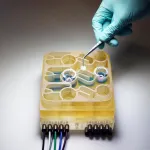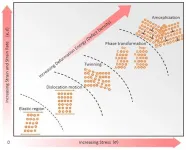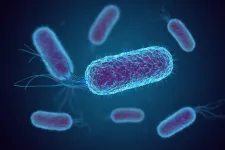(Press-News.org) CAMBRIDGE, MA -- In many ways, our brain and our digestive tract are deeply connected. Feeling nervous may lead to physical pain in the stomach, while hunger signals from the gut make us feel irritable. Recent studies have even suggested that the bacteria living in our gut can influence some neurological diseases.
Modeling these complex interactions in animals such as mice is difficult to do, because their physiology is very different from humans'. To help researchers better understa nd the gut-brain axis, MIT researchers have developed an "organs-on-a-chip" system that replicates interactions between the brain, liver, and colon.
Using that system, the researchers were able to model the influence that microbes living in the gut have on both healthy brain tissue and tissue samples derived from patients with Parkinson's disease. They found that short-chain fatty acids, which are produced by microbes in the gut and are transported to the brain, can have very different effects on healthy and diseased brain cells.
"While short-chain fatty acids are largely beneficial to human health, we observed that under certain conditions they can further exacerbate certain brain pathologies, such as protein misfolding and neuronal death, related to Parkinson's disease," says Martin Trapecar, an MIT postdoc and the lead author of the study.
Linda Griffith, the School of Engineering Professor of Teaching Innovation and a professor of biological engineering and mechanical engineering, and Rudolf Jaenisch, an MIT professor of biology and a member of MIT's Whitehead Institute for Medical Research, are the senior authors of the paper, which appears today in Science Advances.
The gut-brain connection
For several years, Griffith's lab has been developing microphysiological systems -- small devices that can be used to grow engineered tissue models of different organs, connected by microfluidic channels. In some cases, these models can offer more accurate information on human disease than animal models can, Griffith says.
In a paper published last year, Griffith and Trapecar used a microphysiological system to model interactions between the liver and the colon. In that study, they found that short-chain fatty acids (SCFAs), molecules produced by microbes in the gut, can worsen autoimmune inflammation associated with ulcerative colitis under certain conditions. SCFAs, which include butyrate, propionate, and acetate, can also have beneficial effects on tissues, including increased immune tolerance, and they account for about 10 percent of the energy that we get from food.
In the new study, the MIT team decided to add the brain and circulating immune cells to their multiorgan system. The brain has many interactions with the digestive tract, which can occur via the enteric nervous system or through the circulation of immune cells, nutrients, and hormones between organs.
Several years ago, Sarkis Mazmanian, a professor of microbiology at Caltech, discovered a connection between SCFAs and Parkinson's disease in mice. He showed that SCFAs, which are produced by bacteria as they consume undigested fiber in the gut, sped up the progression of the disease, while mice raised in a germ-free environment were slower to develop the disease.
Griffith and Trapecar decided to further explore Mazmanian's findings, using their microphysiological model. To do that, they teamed up with Jaenisch's lab at the Whitehead Institute. Jaenisch had previously developed a way to transform fibroblast cells from Parkinson's patients into pluripotent stem cells, which can then be induced to differentiate into different types of brain cells -- neurons, astrocytes, and microglia.
More than 80 percent of Parkinson's cases cannot be linked to a specific gene mutation, but the rest do have a genetic cause. The cells that the MIT researchers used for their Parkinson's model carry a mutation that causes accumulation of a protein called alpha synuclein, which damages neurons and causes inflammation in brain cells. Jaenisch's lab has also generated brain cells that have this mutation corrected but are otherwise genetically identical and from the same patient as the diseased cells.
Griffith and Trapecar first studied these two sets of brain cells in microphysiological systems that were not connected to any other tissues, and found that the Parkinson's cells showed more inflammation than the healthy, corrected cells. The Parkinson's cells also had impairments in their ability to metabolize lipids and cholesterol.
Opposite effects
The researchers then connected the brain cells to tissue models of the colon and liver, using channels that allow immune cells and nutrients, including SCFAs, to flow between them. They found that for healthy brain cells, being exposed to SCFAs is beneficial, and helps them to mature. However, when brain cells derived from Parkinson's patients were exposed to SCFAs, the beneficial effects disappeared. Instead, the cells experienced higher levels of protein misfolding and cell death.
These effects were seen even when immune cells were removed from the system, leading the researchers to hypothesize that the effects are mediated by changes to lipid metabolism.
"It seems that short-chain fatty acids can be linked to neurodegenerative diseases by affecting lipid metabolism rather than directly affecting a certain immune cell population," Trapecar says. "Now the goal for us is to try to understand this."
The researchers also plan to model other types of neurological diseases that may be influenced by the gut microbiome. The findings offer support for the idea that human tissue models could yield information that animal models cannot, Griffith says. She is now working on a new version of the model that will include micro blood vessels connecting different tissue types, allowing researchers to study how blood flow between tissues influences them.
"We should be really pushing development of these, because it is important to start bringing more human features into our models," Griffith says. "We have been able to start getting insights into the human condition that are hard to get from mice."
INFORMATION:
The research was funded by DARPA, the National Institutes of Health, the National Institute of Biomedical Imaging and Bioengineering, the National Institute of Environmental Health Sciences, the Koch Institute Support (core) Grant from the National Cancer Institute, and the Army Research Office Institute for Collaborative Biotechnologies.
An international team of researchers produced islands of amorphous, non-crystalline material inside a class of new metal alloys known as high-entropy alloys.
This discovery opens the door to applications in everything from landing gears, to pipelines, to automobiles. The new materials could make these lighter, safer, and more energy efficient.
The team, which includes researchers from the University of California San Diego and Berkeley, as well as Carnegie Mellon University and University of Oxford, details their findings in the Jan. 29 issue of Science Advances.
"These present ...
In 2017, the Nobel Prize in Physiology or Medicine went to three scientists who uncovered the molecular mechanisms that control the circadian rhythm, otherwise known as the "wake-sleep" cycle. To carry out their work, the scientists used the common fruit fly Drosophila melanogaster, making this the sixth Nobel to be awarded to research involving it.
Fruitful fruit flies
Life scientists have been using Drosophila for over a century now. First proposed by entomologist Charles W. Woodworth as a model organism, its use in research was pioneered by geneticist Thomas H. Morgan who ran his famous ...
As any cook knows, some liquids mix well with each other, but others do not. For example, when a tablespoon of vinegar is poured into water, a brief stir suffices to thoroughly combine the two liquids. However, a tablespoon of oil poured into water will coalesce into droplets that no amount of stirring can dissolve. The physics that governs the mixing of liquids is not limited to mixing bowls; it also affects the behavior of things inside cells. It's been known for several years that some proteins behave like liquids, and that some liquid-like proteins don't mix together. However, very little is known about how these liquid-like proteins behave on cellular surfaces.
"The separation between two liquids that won't mix, like oil and water, is known as ...
January 29, 2021 -- A study at Columbia University Mailman School of Public Health and Columbia University Irving Medical Center has found that Medicaid expansion in 2014 in New York State was associated with a statistically significant reduction in severe maternal morbidity in low-income women during delivery hospitalizations compared with high-income women. The decrease was even more pronounced in racial and ethnic minority women than in White women. Until now there was little research on the link between ACA Medicaid expansion and maternal health outcomes. The findings are published online in the journal of the International Anesthesia Research Society, Anesthesia & Analgesia.
"Our findings indicate that the 2014 ...
LA JOLLA--(January 29, 2021) As scientists learn more about the microorganisms that colonize the body--collectively called the microbiota--one area of intense interest is the effect that these microbes can have on the brain. A new study led by Salk Institute scientists has identified a strain of E. coli bacteria that, when living in the guts of female mice, causes them to neglect their offspring.
The findings, published January 29, 2021, in the journal Science Advances, show a direct link between a particular microbe and maternal behavior. Although the research was done in mice, it adds to the growing body of science demonstrating that microbes in the gut are important for brain health and can affect development and behavior.
"To our knowledge, this is the first demonstration ...
Boulder, Colo., USA: Sixteen articles were published online ahead of print for GSA Bulletin in January. Topics include insights from the Sawtooth metamorphic complex in Idaho, fingerprinting sand from ancient rivers, eroding Cascadia, and the Troodos ophiolite.
Three-dimensional geometry and growth of a basement-involved fault network developed during multiphase extension, Enderby Terrace, North West Shelf of Australia
Hongdan Deng; Ken McClay
Abstract: Basement fault reactivation, and the growth, interaction, and linkage with new fault segments are fundamentally three-dimensional and critical for understanding the evolution of fault network development in sedimentary basins. This paper analyzes the evolution of a complex, basement-involved ...
CHICAGO (January 29, 2021) -- Structural racism thwarts a large proportion of black patients from receiving appropriate lung cancer care, resulting in worse outcomes and shorter lifespans than white patients with the disease, according to research presented at the 57th Annual Meeting of The Society of Thoracic Surgeons.
"Many studies have shown that there are disparities between the outcomes of black and white patients, but have done little to elucidate why these disparities are occurring," said Chandler Annesi, a medical student from Boston University ...
Languages differ in the sounds they use. The Japanese language, for example, does not distinguish between "r" and "l" sounds as in "rock" versus "lock." Remarkably, infants become attuned to the sounds of their native language before they learn to speak. One-year-old babies, for example, less readily distinguish between "rock" and "lock" when living in an environment where Japanese, rather than English, is spoken.
Influential scientific accounts of this early phonetic learning phenomenon initially proposed that infants group sounds into native vowel- and consonant-like phonetic categories ...
Scientists have given a fascinating new insight into the next steps to develop fast, energy-efficient, future computing systems that use light instead of electrons to process and store information - incorporating hardware inspired directly by the functioning of the human brain.
A team of scientists, including Professor C. David Wright from the University of Exeter, has explored the future potential for computer systems by using photonics in place of conventional electronics.
The article is published today (January 29th 2021) in the prestigious journal Nature Photonics.
The ...
East Hanover, NJ. January 29, 2021. A team of New Jersey researchers has demonstrated that high-dose therapy gait training using robotic exoskeletons may aid early rehabilitation for acute stroke. The article, "Robotic exoskeleton gait training during acute stroke inpatient rehabilitation" (doi: 10.339/fnbot.2020.581815), was published October 30, 2020 in Frontiers in Neurorobotics is available open access at: https://www.frontiersin.org/articles/10.3389/fnbot.2020.581815/full
The authors are Karen Nolan, PhD, Kiran Karunakaran, PhD, and Kathleen Chervin, of Kessler Foundation, Michael Monfett, MD, of Children's Specialized Hospital, Radhika Bapineedu, MD, and Neil N. Jasey Jr, MD, of Kessler Institute for Rehabilitation, and Mooyeon Oh-Park, MD, ...



